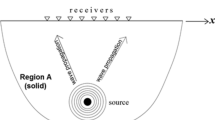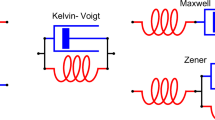Summary
According to considerations put forwards byW. Kuhn andA. Rittmann some years ago, it follows that the chemical composition of the interior of the earth must be rather homogeneous; the well-known discontinuity which occurs at 2900 km with respect to the propagation of longitudinal and transverse waves should not be due to a discontinuity of the material composition (not to an iron core). It is due to a continous decrease of the viscosity and thereby of the relaxation time; transverse waves of a period of e.g. 30 seconds will no more be propagated in a material whose relaxation time for tangential stress is below 30 seconds, while the longitudinal waves will suffer a decrease of the velocity at the same time.
A criticism put forward byA. Eucken consists in the argument that a material in which the time of relaxation for tangential stress becomes equal to the period of the vibration will exhibit a considerable absorption coefficient for longitudinal waves too. It is now shown that the distance on which the period of vibration and the relaxation time are approximately equal is small compared with the wave length of the seismic waves in question, from which it follows that the resulting absorption of the longitudinal waves too will only be small.
A further consideration shows that a mixture of 99 atomic % hydrogen and 1 atomic % of iron is most probably supercritical at a temperature of 5000° abs.
A survey of the solubilities in question shows further that the hydrogen present in a mixture of 90% hydrogen and 10% iron should on the strength of the absorption coefficient be completely absorbed by the iron at 5000° abs. and at a total pressure of 2.106 atmospheres.
The main argument why the assumption of an iron core inside the earth must be dismissed remains the fact that the present state must be the result of an asymptotic processus which at least in its final phase has occurred under conditions similar to the present conditions of temperature, pressure and viscosity; these latter conditions are far from permitting the processus of sedimentation etc. which would be required.
Similar content being viewed by others
References
W. Kuhn undA. Rittmann, Geol. Rdsch.32, 215 (1941), im folgenden als l. c. I bezeichnet;W. Kuhn, Naturwiss.30, 689 (1942), im folgenden als l. c. II bezeichnet.
C. F. v. Weizsäcker, Z. Astrophysik22, 319 (1944).
E. v. Wolff, Nova acta Leopoldina, N. F.12, 381 (1943).
A. Eucken, Naturwiss.32, 112 (1944); vgl. auchA. Eucken Nachr. Gött. Akad. Wiss., Math. Phys. Kl. 1944, Heft 1.
A. Sieverts, Z. phys. Chem.77, 591 (1911).
Landolt-Börnstein, 5. Aufl., 2. Erg. Bd., S. 496.
H. Zeise, Z. Elektrochemie40, 885 (1934).
H. S. Booth undJ. M. Carter, J. physic. Chem.34, 2801 (1930).
Landolt-Börnstein, 5. Aufl., 3. Erg.Bd., S. 247.
S. Postma, Rec. Trav. chim. Pays-Bas39, 534 (1920).
H. Jensen, Z. Physik111, 373 (1938).
Author information
Authors and Affiliations
Rights and permissions
About this article
Cite this article
Kuhn, W. Zur Diskussion über die Homogenität des Erdinnern. Experientia 2, 391–397 (1946). https://doi.org/10.1007/BF02154211
Published:
Issue Date:
DOI: https://doi.org/10.1007/BF02154211




